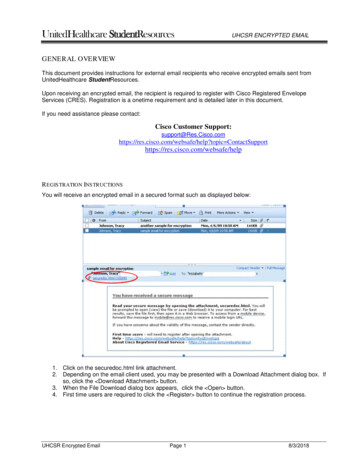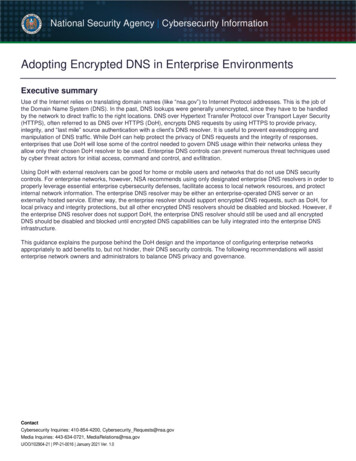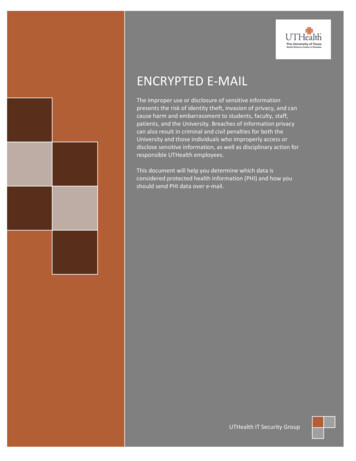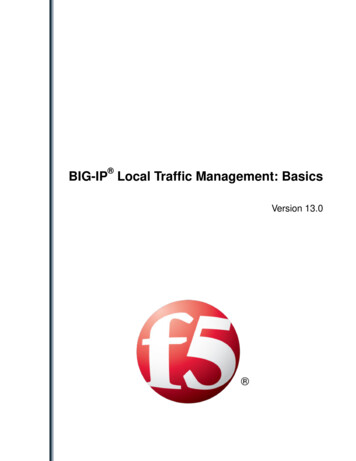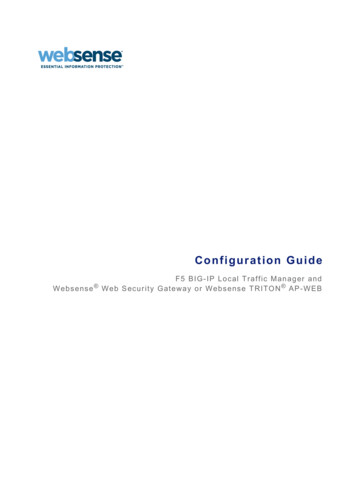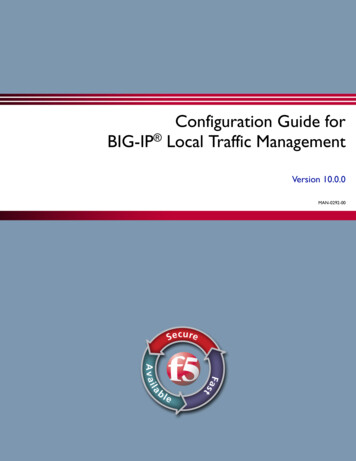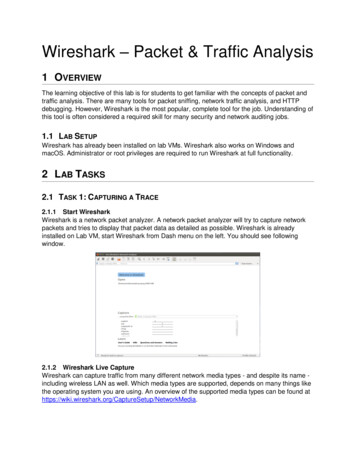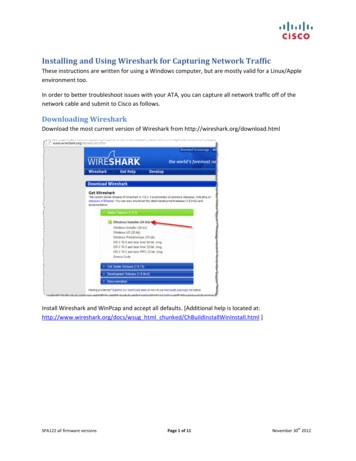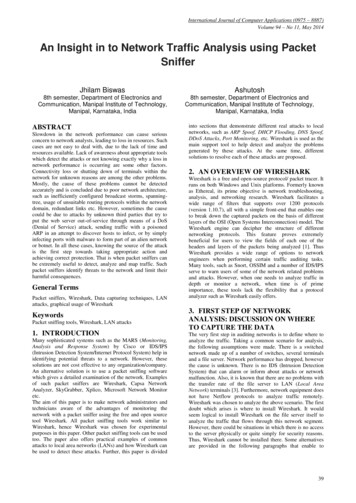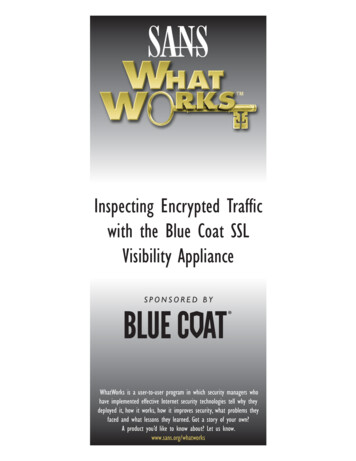
Transcription
Inspecting Encrypted Trafficwith the Blue Coat SSLVisibility ApplianceSPONSORED BYWhatWorks is a user-to-user program in which security managers whohave implemented effective Internet security technologies tell why theydeployed it, how it works, how it improves security, what problems theyfaced and what lessons they learned. Got a story of your own?A product you’d like to know about? Let us know.www.sans.org/whatworks
ABOUT NETTECTSFounded in 2011, NetTects LLC provides solutions and consulting in the computer security,networking, and technology fields. NetTects specialties include network security (IPS, firewalls,application firewalls, remote access, forward and reverse proxies), network identity management(DNS, IPAM, & DHCP), network infrastructure (routers, switches, network management, logging)& high availability (load balancing of servers, sites, WAN links. NetTects partners with vendors ofleading solutions in these spaces, including Blue Coat, Imperva, Infoblox, Fortinet , Juniper, NimbleStorage, PulseSecure, Radware, and Trip Wire. A full range of solutions to complement thesetechnologies from other vendors (remote management, power, etc) is also available.NetTects team members have many years technical, sales, and service experience in the industry.This experience is efficiently utilized to ensure that NetTects clients get best of breed solutionscoupled with professional services providing secure, resilient, and efficient network architecturesand quality deployment and troubleshooting.ABOUT THE USERMichael Weinstein, CTO of NetTects has been with NetTects since its inception in 2011. At NetTects,Michael works daily with clients and leading technology vendors to develop, deploy, and tunesecurity and networking solutions in a variety of small, medium, and large enterprise environmentsacross many verticals. He has worked on networks and supported deployments internationally forclients in many diverse verticals, including financial, media, health care, and retail.With over 15 years’experience in the Value Added Reseller space (ten years as CTO of a Value Added Reseller prior toNetTects), and five years at a manufacturer of security and load balancing solutions, leaving with aDirector level position, Michael brings advanced networking and security skills along with a highlyvalued perspective to clients that fosters long term, trusted relationships with those clients.Having had training and/or completed formal certification programs from a number of vendors(including Juniper, Blue Coat, Radware, Cisco, Network Appliance, Infoblox, APC, Nimble Storage,and Gigamon), Michael assists clients not only with the deployment of NetTects’ vendors’s solutions,but also the integration of the existing environment with those solutions. His understanding ofenterprise environments, networking, security, and availability enables clients to quickly and effectivelydeploy new technologies, resolve security concerns, and provide a stable network for applicationresiliency. Furthermore, Michael’s experience and understanding of complex integrations has alsolead clients to rely on him to assist in remediation of networking and security issues, includingservice outages, DDoS mitigation, and forensic investigations.SUMMARYA large global media company saw both an increase in targeted threats and an increase in encryptedtraffic on its Internet-connected networks. A system integrator tasked with increasing their abilityto inspect encrypted traffic selected the Blue Coat SSL Visibility Appliance.SANS WhatWorksInspecting Encrypted Traffic with the Blue Coat SSL Visibility Appliance
doing on some specific site or what a user is doing on specificenvironments that we needed to get that visibility on. It’s verycommon, at least for the clients that I work with, to go aheadand decrypt things like web mail so we can stop attachmentsthat contain viruses from the Internet. However, to decrypt theInternet as a whole becomes a layer eight issue, and you haveto talk to legal, HR, etc. If you can isolate that and present it tojust a certain set of security tools with limited access to thosetools for the highest level of security and auditing teams in thecompany, it’s much easier and much more palatable to legal andHR than decrypting and logging everything on the proxy.Q Tell us about the company you work for and what roleyou played in the deployment of Blue Coat’s products.A I’m the CTO of NetTects. My responsibilities include designing,deploying, troubleshooting, and training clients on networkingand security solutions. NetTects focuses on a small numberof vendors that are specialized in specific solution sets. Weoffer security gateways, proxy, anti-malware, SSL/TLS inspectionsolutions from Blue Coat. Our clients are a large numberof verticals, including retail, healthcare, financial services andmedia. They range in size from about 100 users to enterpriseswith over 10,000. The specific client that we worked for onthis deployment is a large client in the media space – multipleoffices, different sized offices, from small branches to largefacilities, a couple of large facilities across the world.Q For those key reasons, were you able to convincemanagement to obtain the budget to move forward?A Yes. It came down to the fact that the tools that theywere using could no longer see much of the traffic. So, thebudgeting was really driven from the top down – what dowe need to get this done so that these tools that we have inplace can get this visibility back? Even though we’re doing allthe enforcement on the proxy, it’s nice to have that second setof eyes, on other things that the proxy is not focused on andbeing able to decrypt that traffic.Q Can you walk us through the process you used tolook at possible solutions and how you ended up withBlue Coat?A There were a number of solutions that we looked at, andit was very interesting going through the process becausetopology was a big driver and a big differentiator for a numberof other solutions we looked at. Some of them were verylarge in scale, and they didn’t scale well to smaller sites. Welooked at what they could do, and also had to look at howthey managed the security side of SSL. Since a lot of whathappens is when you start decrypting SSL as a man in themiddle, you’re destroying all of that security that’s built intothe browser. We needed to make sure that we were able toenforce that same level of security, in that every time you getthat Chrome update or IE update that it’s also on this device.The CA lists had to be manageable. The keys had to beprotected as well as what cipher suites could be used, etc. So,that was a big problem for us to solve. The other big one waswe didn’t want another HTTP proxy. A lot of the solutions onthe market said, “Hey, we’re basically an HTTPS reverse proxy,”but we already had that, and we didn’t need to have this manin the middle HTTP proxy. We wanted something that wasprotocol agnostic. As long as it was TLS, whatever went inside,we could decrypt and view what was inside. We didn’t wantto terminate that as an HTTP transaction, for example. Wehad to look at all of those factors to determine what we weregoing to do and how it was going to fit into the environment.Q What was the customer’s problem that you were lookingto solve?A Many of our clients have deployed proxies that can terminateSSL and have some visibility there, but the problem with that isthere’s not a lot of visibility that gets extended to the commontools that are used, like IPS’s, data leak prevention solutions,etc. What we needed to do was have a solution that couldalso audit the security policy and have visibility into that traffic,especially as the traffic volumes for TLS and SSL increase onthe Internet. We also saw that there were some applicationsthat ran inside TLS that weren’t really “proxy-able.” Things likeonline meetings that we might want to have some visibilityinto; but if we proxied them, it tended to break them. So,the problem was to enable inspecting TLS/SSL traffic withoutdisrupting business critical applications.Q So, they had the usual web security gateway, web proxyrequirements for a standard user-to-web type websecurity, but they also wanted to feed decrypted SSLtraffic to other inspection tools, things like IPS and so on?A Yes. IPS, anti-malware, things that are typically sitting out ofpath; and decrypting out of path is more difficult in this dayand age, especially for individual devices to do it. We neededa solution that could go ahead and decrypt that traffic andpresent a copy of not only the plain text traffic, but also thedecrypted traffic, from a single point to these devices that gaveus the visibility we needed, so that the different departmentswithin the organization could get what they needed.Q Was there an incident or an audit report that triggeredneeding to fill this gap or was it that the gap wasrecognized and you moved forward to fill it?A Over time there have been incidents for which we used theBlue Coat solution. As far as investigating what users areSANS WhatWorksInspecting Encrypted Traffic with the Blue Coat SSL Visibility Appliance
Q What is the solution you chose?A After a lot of consideration and looking at those solutions,Q To be clear, you’re still using a separate web proxyapproach for those things and then, the in-line applianceis just being used for this level of inspection?we looked at Blue Coat SSL Visibility Appliance as well, and itwas an in-line device. That always has some unique challenges,A Correct. In theory, I could tell it to send a reset, but it wouldn’tbut what it did do very well was terminate SSL effectively andbe very user friendly. There’d be no custom error message thattransparently. As long as the client had the certificate authoritysays, “Organization has denied your access to this site. Contactinstalled that it was using, it would just pick up on the fact thatsupport if you feel this is incorrect.” You wouldn’t get any ofthere was an SSL hello fromthat because it’s not an HTTPthe client which was really,proxy like the proxies are, butThey actually generate the private keys on the fly;impressive. It didn’t matterit could send a reset. That’swhat the protocol wasnot what we were looking forso your private key isn’t at risk with the next SSLrunning inside TLS, it didn’tbecause we had that layer ofcare. It just copied it off. Itvulnerability that comes out. That was a big benefit for us. security, as you mentioned. Wewas also a nice benefit thatwanted something that wouldit copied all the other trafficat least just allow us to get thatit saw. If there was HTTP traffic, it would copy that also. It justvisibility. The “allows and denies” were done elsewhere. That’sdidn’t do anything with it from the process perspective whichnot to say we might do things like certificate validation in anemergency. For example, “Hey, we want to deny this certificatewas nice, because it meant we didn’t have to have a ton ofenterprise wide, anything signed by it, or this CN.” We couldinterfaces and different places to feed the tools from.certainly do that there or on the proxy. Once we deployed this at that choke point, it was able tofeed the security devices which worked well for us. TheyQ What is the scale and the scope of this. Roughly howalso have the unique feature amongst some of the vendorsmany appliances were deployed?where they don’t use the private key of the CA certificatethat’s deployed for the spoofed server certificate – they onlyA For my largest client, we deployed under 100. There areuse it to sign the spoofed certificate. They actually generatemany that were globally deployed and still deploying. Somethe private keys on the fly; so your private key isn’t at riskof the sites have lots of bandwidth – in excess of gigabytes ofwith the next SSL vulnerability that comes out. That was a bigbandwidth – for Internet access that we had to consider asbenefit for us because it’s always a concern when the wholea solution, which was also nice about the Blue Coat solution.enterprise is dependent upon the certificates and keys that areThe largest solution in a single device has 40 Gbps of packeton these boxes. A lot of the other solutions we looked at didprocessing capability with 9 Gbps of SSL inspection andnot do that, so it was a big benefit. Also, the CA list is easilydecryption. That was impressive as an in-line device. It workedmaintained on the box. If we wanted to add CAs or removeout very well to be able to drop that in and just go from thatCAs that were valid, we could do so easily. It’s an interestingperspective once we decided to deploy. The smaller officessecurity device in that it does have a policy, but that policy ishave a smaller box that can be spec’d for 250 Mbps, 500 Mbps,more action-driven as far as decrypt or not decrypt. I can doetc. So, that was another big differentiator.some enforcement, but mymain enforcement is still theQ Roughly, how many usersThe largest solution single device hasrest of the network. This isare behind all thesemore of an enabler of myappliances?40 Gbps of packet processing capability withother security devices. So, itA In excess of 10,000 at our9 Gbps of SSL inspection and decryption.was really impressive in thatlargest client.regard that it was built withthat in mind.Q Are there policies by Active Directory groups in place It also has the filtering capabilities, so, the whole Internet, asregarding who can go to places other people can’t?Blue Coat categorizes it, is on here. It’s very easy for us toA I’m a traditional security guy. When I deploy proxies, I reallysay, “Hey, don’t decrypt healthcare traffic,” as an example. Welike to authenticate users. I’m not a huge fan of doing reversedon’t want to see someone going to their insurance companylookups into AD and saying, “Okay, that guy’s got this IP. It mustand doing things like that or making a doctor’s appointment,be Dave or Mike.”not of interest to the security group. So, it made it really easyfor us to do that as well.SANS WhatWorksInspecting Encrypted Traffic with the Blue Coat SSL Visibility Appliance
Q So, basically, the CEO’s traffic is going to get treated likeeverybody else’s.AA I don’t like to put anything that’s decrypting outside the firewall.In addition, you may want to have client IP visibility. So, in allthe cases that I worked with it, we’ve always put it inside thefirewall so that you can see the internal IP address in your logs. Absolutely. That’s what you want in an organization.Exceptions should be by group not by individual.Q For typical use, you mentioned the CA list you have onQ Anytime something goes in-line, there are worries notjust about latency but, also about variability, and is it thereason something bad happened in the network? Whatdid you do to make sure in-line behaved well?the proxy. Is it transparent to the users?A It’s transparent to the users as long as they have a sub CAcertificate on these devices, issued by your corporate CAthat everybody knows about already. Then, they are able to,on the fly, spoof the certificate and sign it and, as I mentioned,generate a private key, generate a certificate, sign it, and thenissue it to the client along with their own sub CA as theintermediate certificate. So, it presents all of that. Users don’tsee a thing. It’s good to go.AQ The traffic that’s decrypted is simply passed through toother inspection or controls? You’re not storing traffic?A There’s nothing stored on the devices. They want to knowwhen something’s stored that could possibly be sensitive, thatit’s only on one device. However, as far as whether it can passthe devices in line, the box does have that capability. It’s usedprimarily to feed passive devices or promiscuous devices onthe network. But, this could be used in that fashion as well foran in-line deployment.Q Did you measure any additional latency this causes, orwas it essentially put in a test mode that nobody noticedand away it went?A e didn’t take millisecond measurements of the deltasWcompared with going direct. It’s a proxied environment. So,some of the things are being decrypted already. They mighteven be decrypted twice now. Once by the proxy and thenonce by this device because it’s feeding different tools anddifferent goals. It was not noticeable by us when we weretesting. We took the whole IT department and put it on theproxy that had this in line and everything was decrypted. It’spretty interesting when you look at the pcaps when you’retesting it off of the security devices.Q Once you made the decision to go with Blue Coat, howlong did it take to roll out.A Once we configured the networking perspective at each facilityand each type of topology and how it was going out, they wentin relatively easily.Q As it relates to topology, the inspection appliance isinside or outside the firewall?SANS WhatWorks We did a good bit of fail-over testing where we did upgradeson the boxes and rebooted them and pulled them in andout of line and things like that. At some of the more criticallocations to waylay those fears, we actually used a visibilitydevice. In this case it was a Gigamon that we put in placethere so that we could toggle traffic. It also gives us anexternal health check for that device, which is nice, so that weknow that it is healthy. And if it’s not, it can take action andeither bypass or just alert us. We did test the port, the failopen capability. Unplug the box, traffic just goes right throughit. So, that’s a nice advantage. Obviously, any sessions that wereterminated, they have to be restarted because those keys aregone. But, it worked fine. The long and short of it is we got alot of great management out of it. And as far as latency, mostof this was Internet traffic. So, any latency that it added wasnegligible. We didn’t notice.Q You mentioned tens of appliances.How are theymanaged? Do you touch each box to manage it? Isthere a management server? How you do that?A Blue Coat has a central management server so you can pushpolicy devices, back them up and things like that. If you’rebuilding your polcies based upon the Blue Coat categories,those are automatically updated. For example, if I choosehealthcare, Blue Coat’s going to maintain that list and feed rulesthrough what they call the Global Intelligence Network.Q For the global network, can you pre-configure thebox and ship it out and they install, or is it that youessentially have to be on the local network getting it towork right?A I’m a big fan of console ports, so for most of my customers,I’ll say to them “if you’re going to ship it out and it’s notpreconfigured, just put a console server on it. We’ll log in andget it up and running, and then plug in the network interfaceand will be good to go.” They can also be pre-configured.Some of the devices have an on-box screen as well, so evena hands-on site could do it if we give them instructions, walkthrough and give it a base IP; plug in the management port forus. It’s not my favorite method. I’d much rather have a consoleserver that I can log everything and see what’s going on; but, ina pinch, it works in an emergency.Inspecting Encrypted Traffic with the Blue Coat SSL Visibility Appliance
Q How long has it been operational?A We started the process about two years ago.up and running for almost a year now.Q I think that’s an interesting topic.So, we’ve beenQ Where are you now?You went through the deploymentand a year of operation. Any lessons learned? Thingsyou know now you’d do differently that you could passon?I was actually goingto bring up Heartbleed. What did it mean operationallywhen Heartbleed came out? What did it mean to theoperation of the appliances?A Well, from this perspective, a lot of this stuff is what sites arethe end users internally accessing? So, Heartbleed was a littlebit less of a risk in that regard in that you count on the webservers/service providers to fix their servers. Obviously, wewante
& high availability (load balancing of servers, sites, WAN links. NetTects partners with vendors of leading solutions in these spaces, including Blue Coat, Imperva, Infoblox, Fortinet , Juniper, Nimble Storage, PulseSecure, Radware, and


